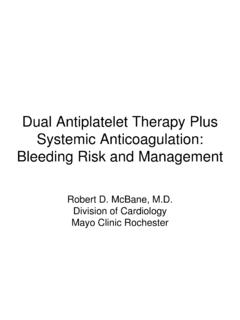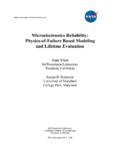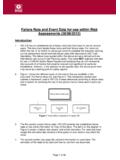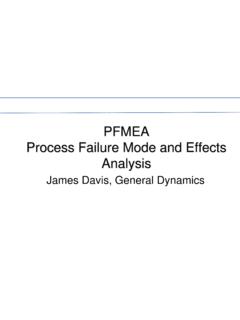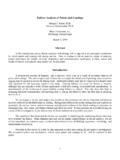Transcription of Dx Acute Resp Failure Signs and Symptoms
1 12/27/20131 Acute Respiratory FailureFamily Medicine Update Big Sky, MontanaJanuary, 2014 Mark Tieszen, MD, FCCM, FCCPS anford Medical Center FargoCritical Care Respiratory FailureRecognitionEtiologyAirway assessment and managementRSI/induction agentsAlternate devicesDx Acute Resp Failure Difficult to define but I know it when I see it Very subjective diagnosisSigns and Symptomssubjective feeling of shortness of breathtachypneausing accessory muscles of respirationparadoxical abdominal movements with breathinginability to talk w/o gasping for aircyanosis (mucus membranes, nail beds)skin mottling decreased mental statusunstable vital signsabnormal lung soundscough and purulent sputumImportant Signs and Symptomstachypneausing accessory muscles of respirationparadoxical abdominal movements with breathinginability to talk w/o gasping for airStages of ABG spH pCO2pO2 Stage 0 40 100 normalStage 1 20 100 Stage 2 20 70 Stage 3 37 70 Stage 4 60 50 12/27/20132 Stages of ABG spH pCO2pO2 RRStage 0 40 100 16 Stage 1 20 100 30 Stage 2 20 70 30 Stage 3 37 70 30 Stage 4 60 50 20 - 40 ABG
2 Stages in COPDpH pCO2pO2 Stage 0 50 60 baselineStage 1 40 60 Stage 2 40 50 Stage 3 50 50 Stage 4 150 30 Etiology Resp FailureLung Parenchymal DiseaseCOPDP neumoniaCHFS epsisPulmonaryHypoventilationDrug overdoseHead injuryNeuromuscular diseaseEmbolismPulmonary PathophysiologyCO2diffuses across the alveolar membrane 200 x better than O2 Hypoxia with normal pO2is always lung parenchymal diseaseHypoxia with an elevated pCO2could be primary hypoventilation or could be severe lung parenchymal diseaseHypoxic resp Failure vs Hypercapnic resp failureA-a gradientAlveolar to arterial oxygen gradientA is estimated from a formulaa is from the ABGA is estimated from the following formula.
3 A = FiO2(Pb - PH2O) - pCO2/RQA = FiO2(760 - 47) - pCO2/RQ A = FiO2(713) - pCO2/RQA = FiO2(700) - pCO2A-a gradient = FiO2(700) - pCO2 pO212/27/20133In the normal individual breathing room air with a normal pO2of 100 and a pCO2of 40A = (700) - 40A = (147) - 40A = 107A-a gradient = 107 - 100 = 7 The normal A-a gradient is < 10 FORMULAS TO REMEMBERA-a on room air= 150 - pCO2- pO2A-a on oxygen= (FiO2x 700) - pCO2- pO2 Resp Failure Differential DiagnosisA-ainc FiO2 Etiologyhypoventilation nl PaO2incDrugs, head injurydead space inc PaO2incCOPD shunt fraction inc PaO2not inc pneumonia, CHF, PEResp Failure Differential DiagnosisA-ainc FiO2 Etiologyhypoventilation nlPaO2incDrugs, head injurydead space incPaO2incCOPD shunt fraction inc PaO2not inc pneumonia, CHF, PEReally only applies at high FiO2 levels > 60 %100 % oxygenation FiO2 challenge and calculate the change in the pF ratio (pO2/FiO2)
4 Pulmonary EmbolismYes, in autopsy series there are some missed PEsIn the real world, common things happen commonlyIf your patients presents with a good explanation for their resp Failure there is no reason to add PE to the listPulmonary EmbolismD-dimer only helpful when negativenegative means no PEpositive means nothinga very high D-dimer still means nothingNot all D-dimers are created equalknow which one your hospital usesUse a prediction scoreWells score12/27/20134 Wells CriteriaClinical Symptoms of DVT (leg swelling, pain with palpation) Other diagnosis less likely than pulmonary embolism Heart rate >100 Immobilization ( 3 days) or surgery in the previous four weeks Previous DVT/PE Hemoptysis Malignancy Probability Score High > Moderate to Low < needed to make decisionsHistory Acute HPI Chronic Past Med HxExam Vital Signs General assessment How do they look Lung soundsABGCXRDo they need mechanical supportIn shock?
5 Hypercapnic with complications? Hypotension ,hypoxia, widened QRS complex, not resolved with O2?Look Bad? Increased work of breathing Decreased level of consciousnessWhat kind of mechanical support?Non-Invasive Ventilation (NIV) BiPap or CPAPE ndotracheal intubationIndications for NIVA cute Respiratory Failureintact mental statusairway protectedabsence facial traumapatient will toleratesuccess rate 25 %Non-Invasive VentilationTakes patience to initiateTry several different masks to find right fitStart with low settings and work up to full settings and mask fittingMay need some sedationversed12/27/20135 How long to tryAfter get patient settled on NIV15-20 minutesShould look better in one hourIf not better consider intubationIndications for intubationAcute Respiratory Failurefailure of NIVdecreased mental statusunprotected airwayshockemergenciesneed high pressuresTransport DecisionsComplex questionEquipment and personnel availableDistance of transportIntubation and SedationPlease keep
6 Your patient comfortable post intubation Sedation and analgesia If hypotension develops then More fluid Early pressorsAvoid repeat doses of neuromuscular blockers for transportMedications for TransportSedationAnalgesiaIsotonic fluidsVasopressorParalytics rarely needed for transportAirway ManagementEndotracheal Intubation is by far and away the best, safest and preferred technique to management the Acute respiratory Failure patients airway12/27/20136 NoviceIntubation is perceived as scaryReality is that is not that hard a skill to masterFrist resource for training should be on a dummyone hour once in a lifetime sufficientIn OR do some elective intubationsrepeat that every 1-2 yearsRAPID SEQUENCE INTUBATION RSI is the standard of care in emergency airway management for intubations not anticipated to be difficultsimultaneous administration of a sedative and a neuromuscular blocking agent to render a patient rapidly unconscious and flaccid in order to facilitate emergent endotracheal intubation and to minimize the risk of aspiration.
7 Multiple studies confirm the high-success rate of RSI using the combination of a sedative and a paralytic drug Induction Agentsmidazolam (Versed)PropofolFentanylKetamineEtomidat eNeosphyenineFluidsmidazolam (Versed)Dose 2-4 mg (induction dose is listed as mg/kg)Onset 1-5 minutesDuration 5-30 minutesAmnesic effectPropofol60 kg100 kgDose ( mg/kg)50 mg100 mgOnset seconds15-45 Duration minutes 5-10 minutesReduces airway resistance, decreases ICP, good antiepilepticDoes vasodilate cause hypotensionFentanylPersonal experience more than guidelines60 kg100 kgDose mcg/kg60 mcg100 mcgOnset minutes1 Duration minutes 5-15 12/27/20137 Rocuronium60 kg100 kgDose mg/kg35 mg60 mgOnset 1-2 minutes (typically faster)Duration 5-15 minutes (typically quicker)Nondepolarizing agent Succinylcholine60 kg100 kgDose mg/kg90 mg150 mgOnset seconds45-60 Duration minutes 6-10 Depolarizing agentHyperkalemic cardiac arrest (Are defined risks groups but can occur in anyone)No longer recommended in any patientsEtomidate60 kg100 kgDose mg/kg20 mg30 mgOnset minuteDuration 3-5 minutesCauses less hypotensionAdrenal insufficiency, inc mortality in septic patients, no longer used in the ICUK etamine60 kg100 kgDose 1-2 mg/kg 60-100 mg 100-200 mgOnset 1 minutesDuration 5-15 minutesLess hypotensionMay increase ICP (evidence weak)Can be used for awake intubations (preserves resp drive)
8 Reemergence phenomenon concerningPhenylephrineNeosynephrineIV bolus dosing 100 mcg q 5 minutesIV infusion dose 0-4 mcg/kg/min100-200 mcg/minuteHypotension is so common Neo should be part of your induction agent medical listMost Patients are DryHave NS hanging and do not hesitate to give 1-3 litersHave not been eating wellInduction agents will vasodilateEven the CHF patient may be intravascular dry and need some fluid12/27/20138 What do I doVersed 4 mg IV given while I set up to intubate50-100 mcg fentanyl and 50-100 mg of propofolStart to bag mask ventilate as they fall asleep (eyelash test)Look, if fail then more sedation +/-rocuroniumWhat do I do (2)3 attempts with laryngoscopeWatch sat s and heart rateabort attempt and bag when pulse starts to fallGlidescopeConsider a intubating styletCricothyroidotomy (kit)
9 To RSI or Not to RSIMost fellowship trained ED MDs always RSII will usually try once without paralytic and use it if I think I will get a better view on the second attemptMore likely to use RSI if no concerns after an LEMON airway assessment, TBI, overdose patient, full stomachIntubation Failure RatesDifficult intubation rate quoted as 30 %more than one attemptUnsuccessful intubation rate 10 %Prediction of the Difficult AirwayLEMON approachLook externallyEvaluate 3-3-2 ruleMallampati scoreObstruction/ObesityNeck mobilityLook externallyClinician s general impressionabnormal facies or body habitusunusual anatomyfacial traumaSpecific but not sensitiveIf it looks like a difficult airway then it most likely will beAbsence of external Signs of a difficult airway does not predict success12/27/201393-3-2 RuleA.
10 Extent of mouth openingB. Size of the mandibleC. Distance between mentum and hyoid of mouth openingPatient should be able to fit three of their own fingers between the of the mandiblePatient should be able to place three of their own fingers along the floor of the mandible between the mentum and the neck/mandible between mentum and hyoid bonePatient should be able to place 2 of their own fingers in the superior laryngeal notchIf larynx is too high (anterior) hard to see12/27/201310 MallampatiPredicts the view during laryngoscopy based on the view looking into the patients open mouthClass I or II easy laryngoscopyClass III difficultClass IV extreme difficultlyM score in the EDOften patients unable to cooperateOpen the mouth with tongue blade of laryngoscope blade and try to get the best view possibleO.
